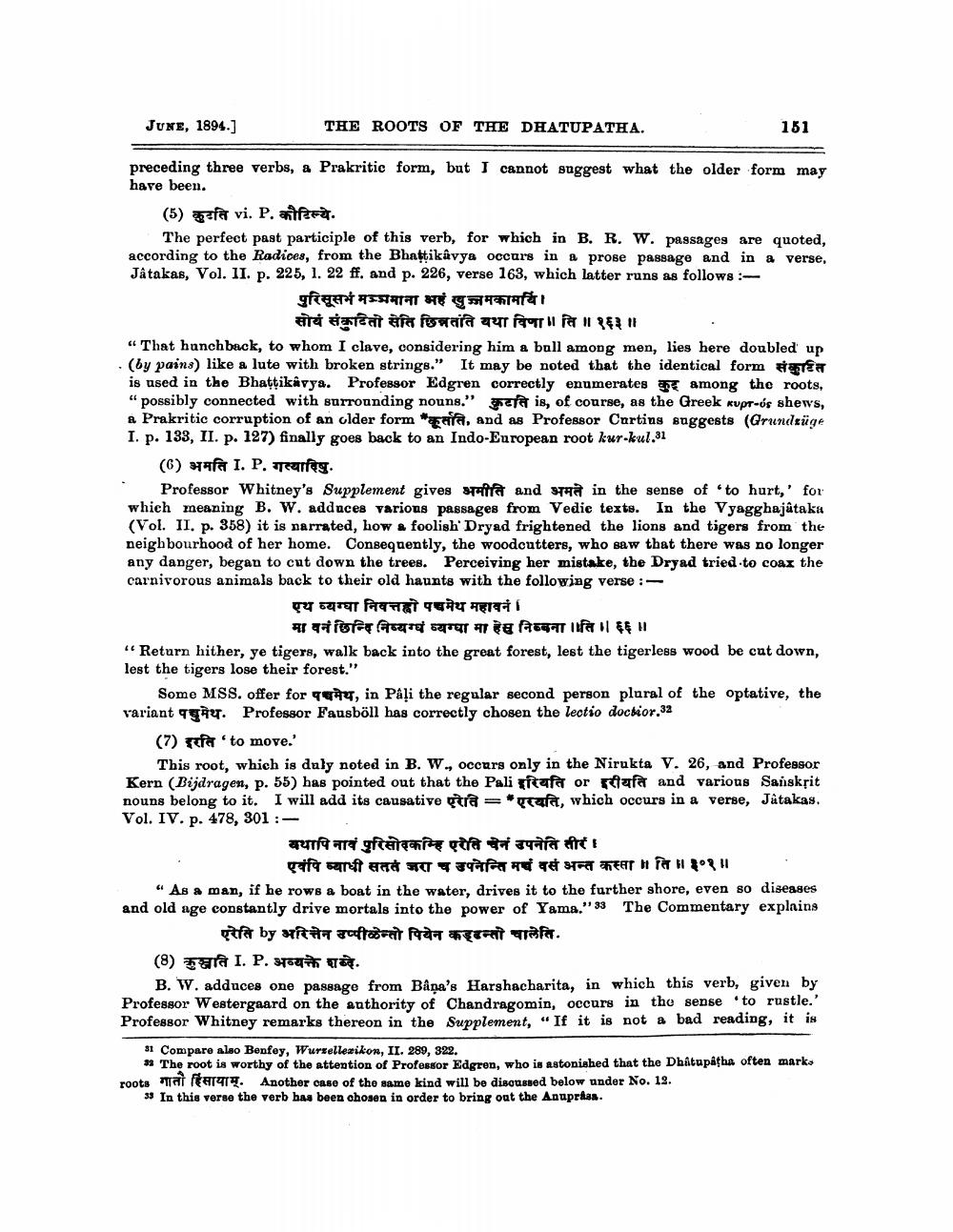________________
JUNE, 1894.]
THE ROOTS OF THE DHATUPATHA.
151
preceding three verbs, a Prakritic form, but I cannot suggest what the older form may have been.
(5) gefa vi. P. artefat.
The perfect past participle of this verb, for which in B. R. W. pagsages are quoted, according to the Radices, from the Bhaktikavya occurs in a prose passage and in a verse, Jatakas, Vol. II. p. 225, 1. 22 ff, and p. 226, verse 163, which latter runs as follows:
पुरिसूसभ मम्ममाना अहं खुज्जमकामर्यि।
सोयं संकुर्दितो सेति छिन्नतति यथा विणा । ति ॥ १३ ॥ « That hanchback, to whom I clave, considering him a bull among men, lies here doubled up . (by pains) like a lute with broken strings." It may be noted that the identical form # rea
is used in the Bhattikävya. Professor Edgren correctly enumerates 57 among the roots, "possibly connected with surrounding nouns." era is, of course, as the Greek kupr-ós shews, a Prakritic corruption of an older form saia, and as Professor Cartins suggests (Grundzüge I. p. 133, II. p. 127) finally goes back to an Indo-European root kur-kul.31
(6) wafa I. P. Teurleg.
Professor Whitney's Supplement gives it and that in the sense of .to hurt,' for which meaning B. W. adduces various passages from Vedie texts. In the Vyagghajataka (Vol. II. p. 358) it is narrated, how a foolish Dryad frightened the lions and tigers from the neighbourhood of her home. Consequently, the woodcutters, who saw that there was no longer any danger, began to cut down the trees. Perceiving her mistake, the Dryad tried to coax the carnivorous animals back to their old haunts with the following verse :
एय व्यग्घा निवत्तह्वो पञ्चमेथ महावनं ।
मा वनं छिन्दि निष्यग्धं व्यग्घा मा हेस निम्बना ।ति ।। ६६॥ "Return hither, ye tigers, walk back into the great forest, lest the tigerless wood be cut down, lest the tigers lose their forest."
Some MSS. offer for 9 4, in Paļi the regular second person plural of the optative, the variant age. Professor Fausböll has correctly chosen the lectio dockor.32
(7) fa 'to move.'
This root, which is duly noted in B. W., occars only in the Nirukta V. 26, and Professor Kern (Bijdragen, p. 55) has pointed out that the Pali itafa or tafar and various Sansksit nouns belong to it. I will add its causative tra=urafa, which occurs in a verse, Jåtakas. Vol. IV. p. 478, 301 :
यथापि नावं पुरिसोरकम्हि एरोति चेनं उपनति तीरं ।
एवंपि व्याधी सतत जरा च उपनेन्ति मर्च वसं अन्त कस्ता । ति॥१॥ “ As a man, if he rows a boat in the water, drives it to the further shore, even so diseases and old age constantly drive mortals into the power of Yama." 33 The Commentary explains
एरेति by अरित्तेन उप्पीळेन्तो पियेन कड्डन्तो चालेति. (8) Tata I. P. youth .
B. W. adduces one passage from Bana's Harshacharita, in which this verb, given by Professor Westergaard on the authority of Chandragomin, occurs in the sense to rustle.' Professor Whitney remarks thereon in the Supplement, “If it is not a bad reading, it is
31 Compare also Benfey, Wursellexikon, II. 289, 322.
» The root is worthy of the attention of Professor Edgren, who is astonished that the Dhâtupatha often mark, roots at FATTE. Another case of the same kind will be discussed below under No. 12.
39 In this verse the verb has been chosen in order to bring out the Anupraas.




